Vinca Minor (Periwinkle) Is An Excellent Set-And-Forget Plant To Help Suppress Weeds

PERENNIALS > PERIWINKLE
Reviewed By COLIN SKELLY

Colin is a Horticulturist and Horticultural Consultant with experience in a range of practical and managerial roles across heritage, commercial and public horticulture. He holds the Royal Horticultural Society’s Master of Horticulture award and has a particular interest in horticultural ecology and naturalistic planting for habitat and climate resilience.
IN THIS GUIDE
PERIWINKLE GUIDES
Vinca minor, more commonly known as ‘Periwinkle’, is a low-growing perennial that’s widely used as weed-preventative ground cover.
An extremely tough customer, it requires very little in the way of upkeep or maintenance, making it an excellent choice for set-and-forget corners of the garden.
Its ability to thrive in low-light conditions and tolerate drought with ease makes it an ideal option for planting underneath trees or in shady alcoves where nothing else seems to grow.
The evergreen nature of its foliage provides colourful intrigue throughout the calendar year, while the bright blossoms in spring and summer are an additional plus.
Overview
| Botanical Name | Vinca minor |
| Common Name(s) | Common Periwinkle / Lesser Periwinkle / Myrtle / Dwarf Periwinkle |
| Plant Type | Perennial |
| Native Area | The Mediterranean and Southern Europe |
| Hardiness Rating | H6 |
| Foliage | Evergreen |
| Flowers | Blue, purple or white flowers rotating out from a yellow stamen |
| When To Plant | Spring or autumn |
| When To Prune | August-November |
Sunlight
Preferred
Full Sun or Partial Shade
Exposure
Exposed or Sheltered
Size
Height
0 – 0.1M
Spread
1 – 2M
Bloom Time
Spring / Summer
Soil
Preferred
Most fertile soils
Moisture
Moist but well-drained
pH
Any
A native of the sultry climes of southern Europe and the Caucusus, Vinca minor has adapted remarkably well to the less predictable and hospitable weather in the UK.1Vinca minor. (n.d.). Kew Royal Botanic Gardens. Retrieved March 22, 2023, from https://powo.science.kew.org/taxon/urn:lsid:ipni.org:names:82701-1
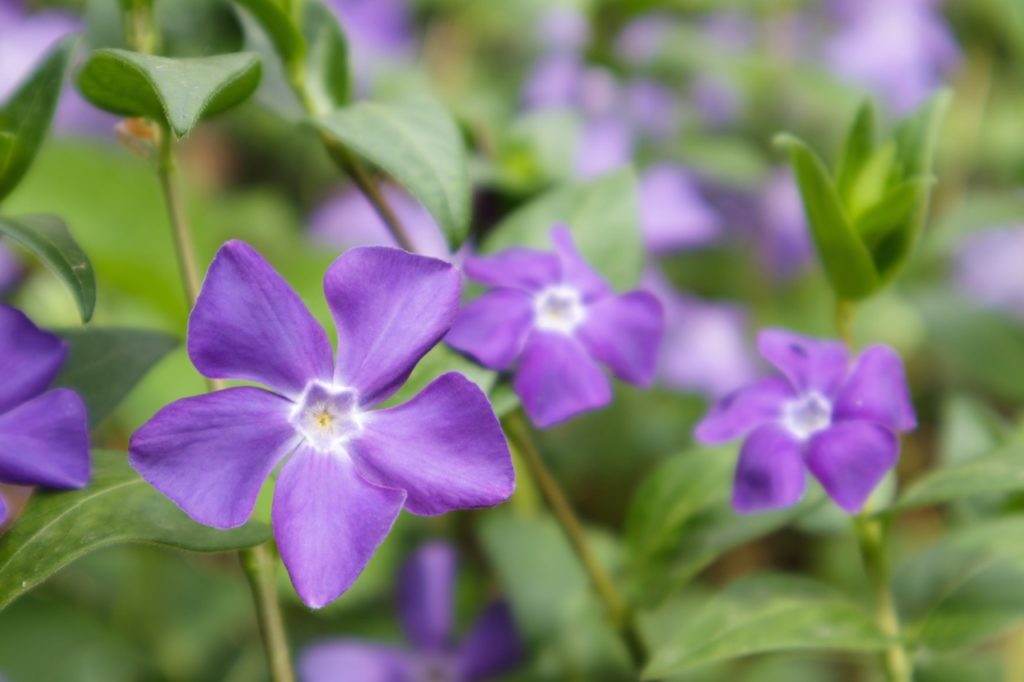
It’s a common sight in parks and even graveyards around the country today, while its ease of cultivation makes it a popular choice for green-fingered enthusiasts too.
Is Vinca Minor Invasive?
V. minor is a very vigorous and resilient grower and will require little to no maintenance from your side in order to continue thriving.
In fact, my primary recommendation when caring for this plant would be to keep it from growing too vigorously and overstepping the mark.
Having said that, the plant is fairly easy to control and is not considered invasive here in the UK.
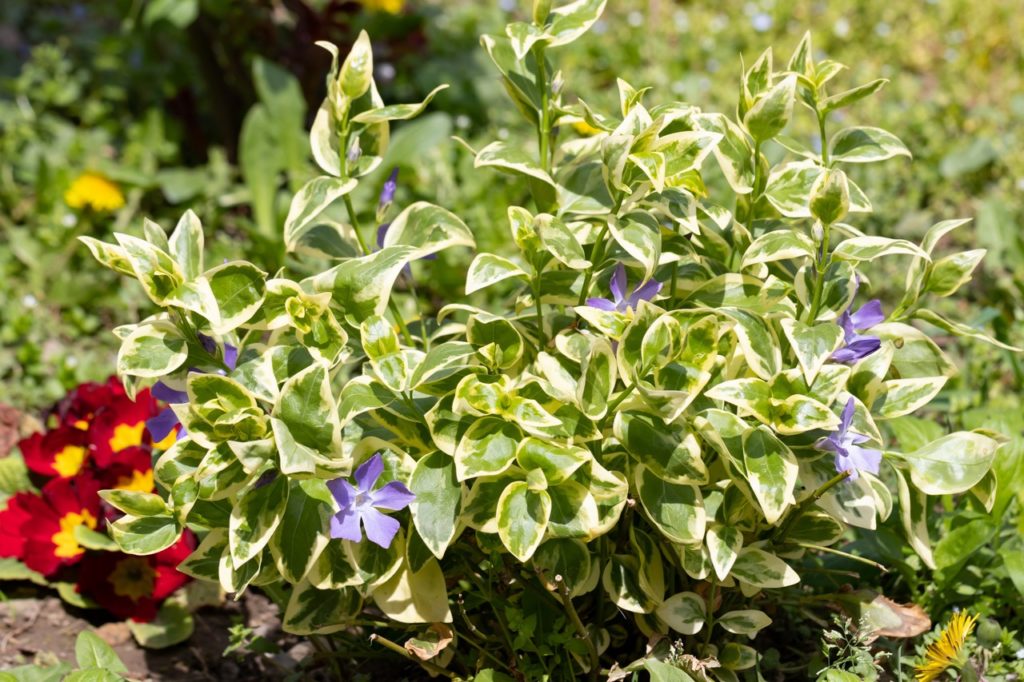
Vinca major – or greater periwinkle – is another kettle of fish entirely.
This species is extremely invasive and will encroach on the territory of any neighbouring plants in its vicinity since it has a tendency to send down roots wherever its stems touch the soil.2Vinca major. (n.d.). Plant Right. Retrieved March 22, 2023, from https://plantright.org/invasive/vinca-major/
As a result, it’s highly advisable to ensure you are indeed planting V. minor (and not V. major) in your garden.
Common Varieties
The RHS Plant Finder lists 80 different forms or cultivars of V. minor.
Most send forth bluish-purple flowers each spring and summer, but there are others which offer up lavender or even white blossoms as well.
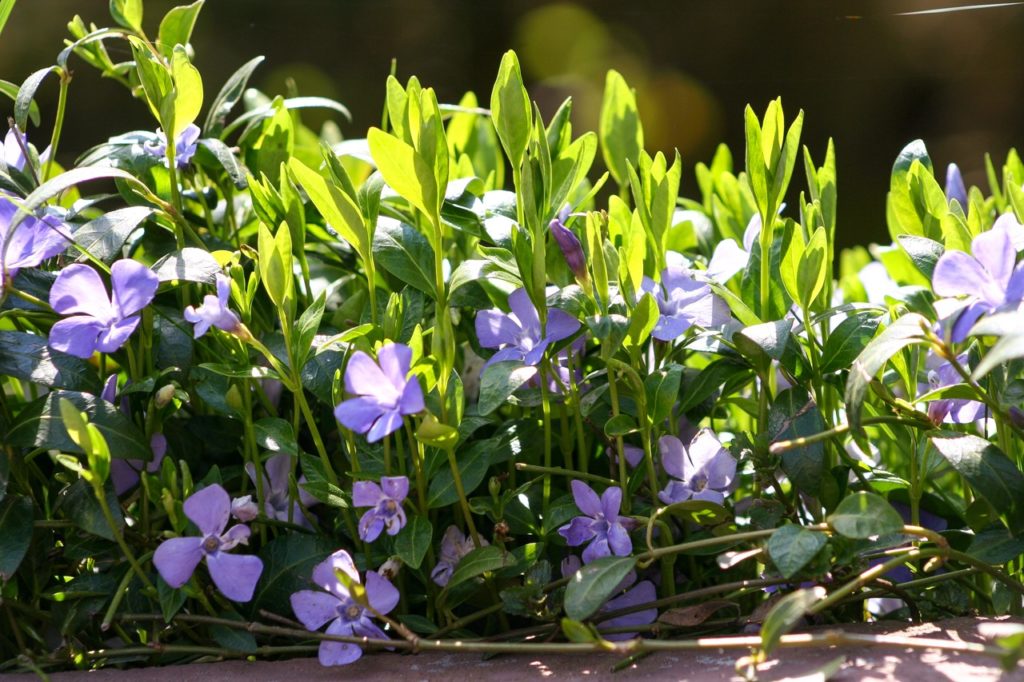
Here are some of my personal favourites:
V. minor ‘Atropurpurea’
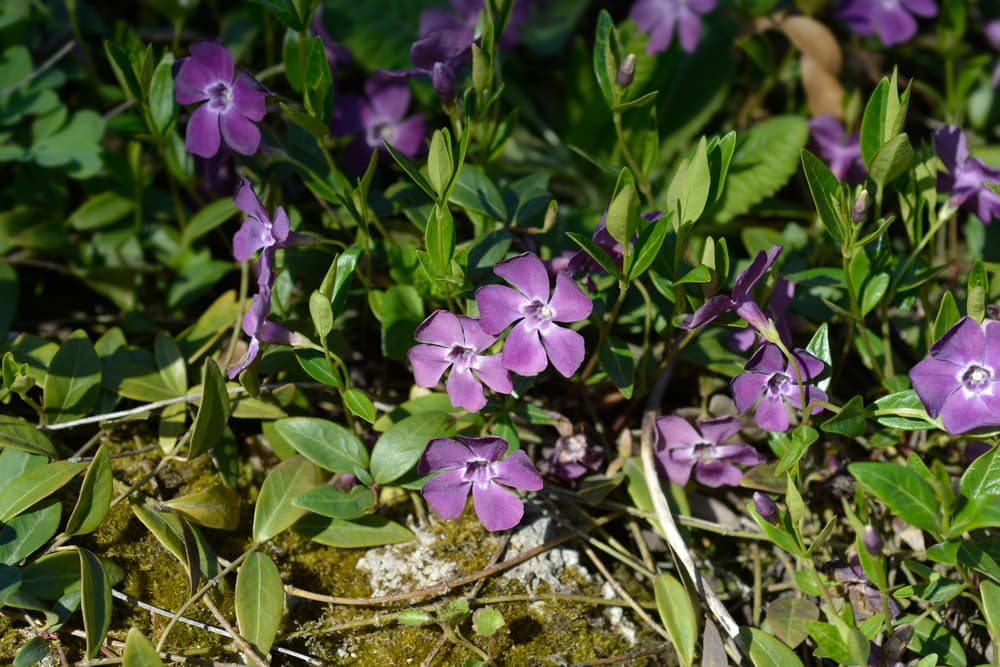
This variety produces bright green foliage and is complemented by a deep reddish-purple hue to the flowers, which makes for an extremely eye-catching package.
V. minor f. alba ‘Gertrude Jekyll’
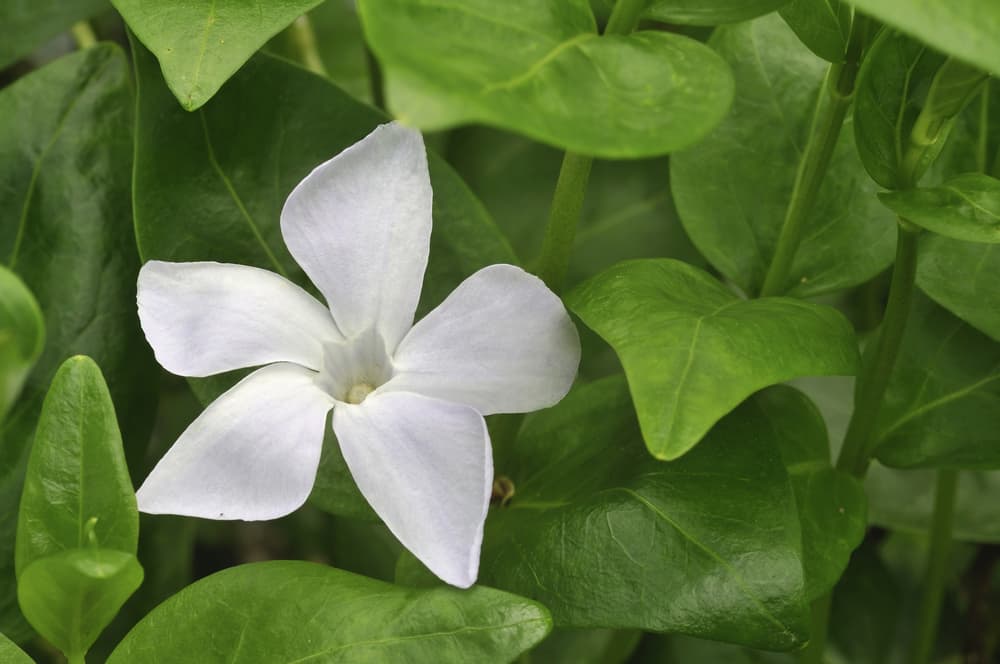
There’s a delicious contrast between the dark tones of the green leaves and the brilliant whiteness of the floral blossoms on this showstopper.
V. minor ‘Illumination’

The variegated foliage on this specimen contrasts green with veins of gold, while the striking blue flowers add even greater appeal.
V. minor ‘Variegata’
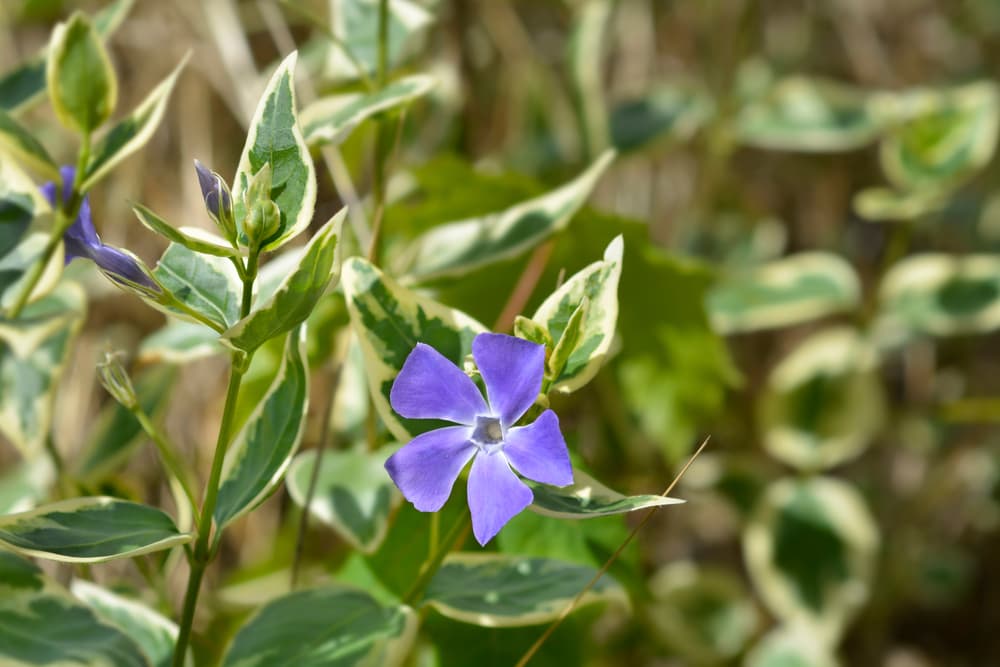
As the name suggests, this is another option with variegated foliage and blue flowers, though this time green is blended with creamy white on its leaves.
Sowing From Seed
Growing V. minor from seed is possible, but it’s a trickier affair than propagation via division or from nursery plants.
That’s due to the fact that you’ll need to give the seeds extra care in their first few months of life and because they grow more slowly from seed.
Having said that, it’s perfectly feasible to sow periwinkle seeds if you’d prefer to do so.
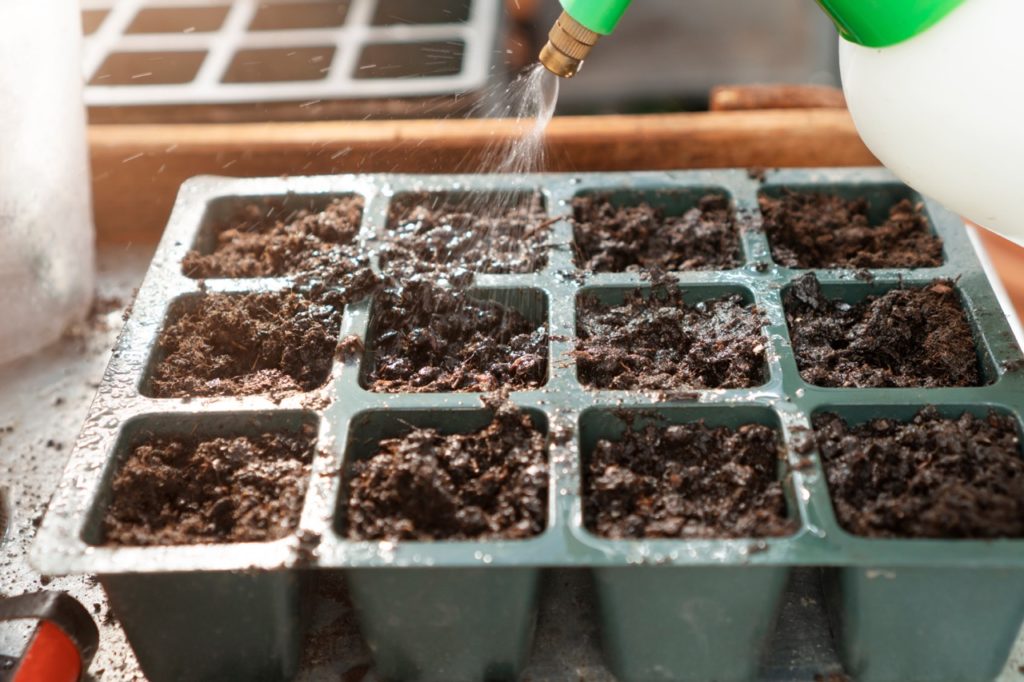
Begin by filling a seed tray with a potting mixture and watering the compost thoroughly so that excess liquid drains from the bottom.
Place 3-4 seeds in each cell and cover them with 5mm of soil, then firm down gently and mist.
Cover the seed tray with a black plastic bag to retain moisture but block out direct sunlight, then place it in an area which enjoys a stable temperature of around 25°C – you can use a heat mat or other apparatus if necessary.
After germination has occurred (normally within 1-2 weeks), remove the plastic bag and place the tray on a sunny windowsill.

Keep the soil moist and fertilise with a standard fertiliser after around 10 days.
Thin out the seedlings in each cell, keeping only the most healthy, and transplant them to their own pot around 10cm in diameter once they have reached a height of 8cm and show leaves.
Feed with fertiliser once more after a fortnight.
Planting
When the plant is big enough to transplant outside, dig a hole big enough to fit the root ball and place it gently into it, then fill in the excess area with soil and water thoroughly.
If you are not planting from seed (but from division, for example), simply cut off a section of the desired plant, ensuring that the root ball is big enough to survive on its own.
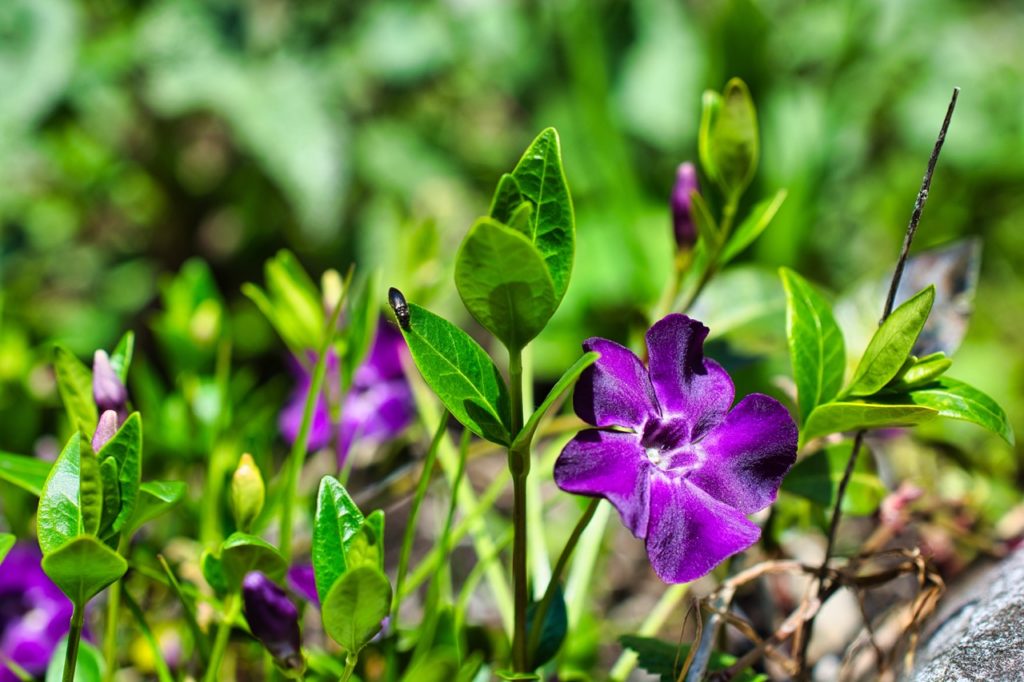
Ensure that cuttings are kept at least 30cm apart to give them enough room for their roots to fully develop and voila!
Your periwinkle will become self-sufficient in next to no time.
You can use more than one seedling to cover a larger area, but be mindful that a single modestly sized plant is capable of spreading up to 2m in diameter.
Periwinkle Plant Care
Generally speaking, periwinkles are extremely easy to care for, which is why they’re so popular across the British Isles.
Aspect
For the best results, you should plant V. minor in a partially shaded area of the garden.
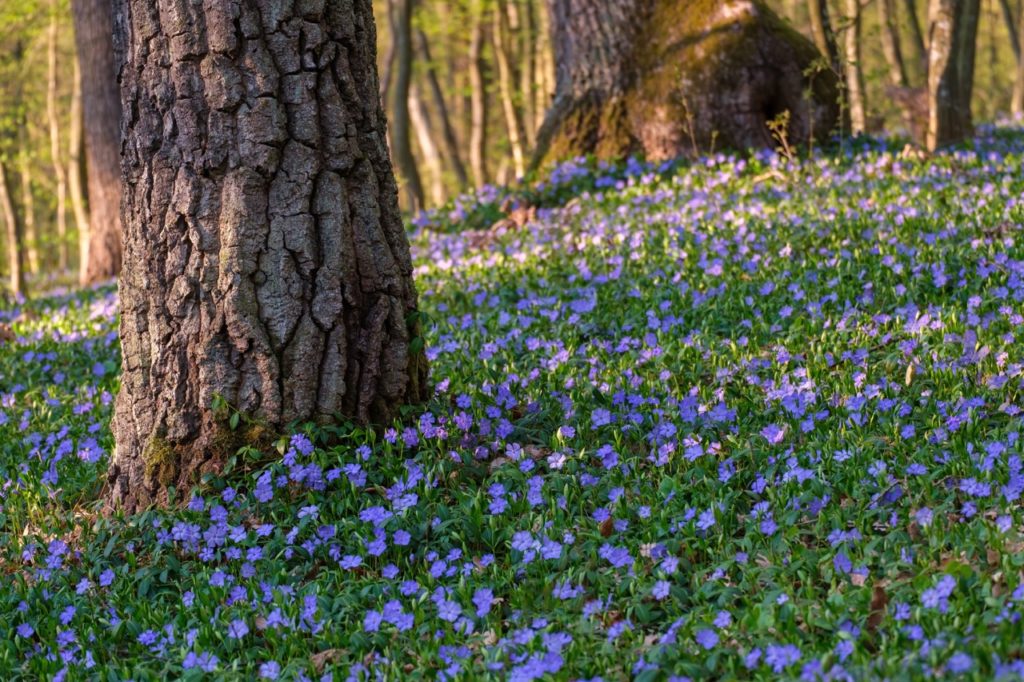
However, one of its strongest qualities is its ability to do well in darker spots.
However, avoid exposing it to direct sunlight as it may burn and die.
Preferred Soil
Periwinkle prefers soil that is fertile and well-draining, but again, it’s unfussy in this aspect and will accept almost any soil type.
If you do find that your garden is home to particularly difficult terrain, you can improve it by adding mulch or well-rotted organic matter to the soil prior to planting.
Watering
Periwinkle is fairly drought resistant and won’t require much in the way of irrigation after its initial planting.
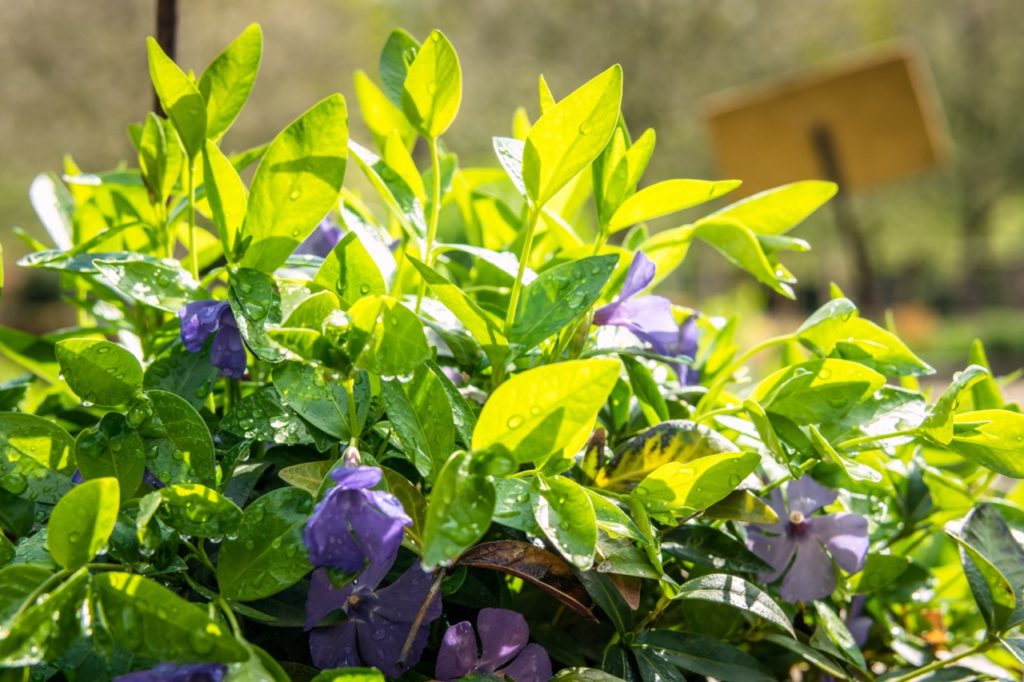
This is why I like to use it as a ground cover underneath trees and other taller plants since its roots won’t compete for moisture or inhibit their growth.
Pruning
Pruning periwinkle is entirely optional.
However, its fast-growing nature means you may want to keep it in check so that it doesn’t disrupt the harmony of your garden.
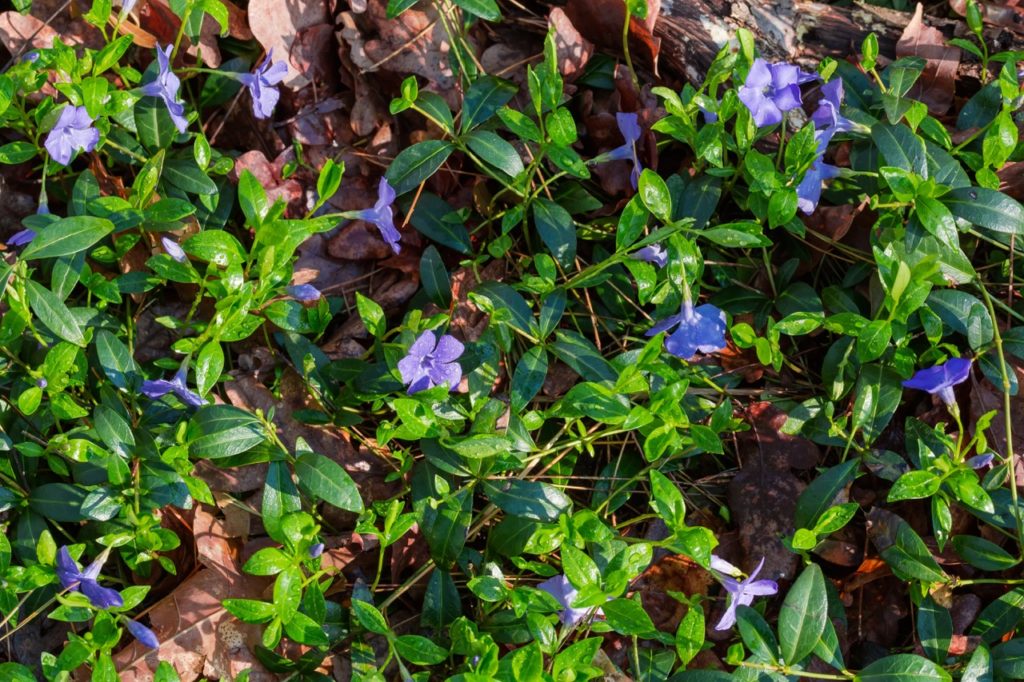
If you are going to prune, I recommend that it’s best to do so once the final blooms of the season have begun to fade, which normally occurs in late summer.
Common Pests
The most common afflictions affecting periwinkle are the same ones which you will likely have experienced with many other garden plants.
That includes all manner of creepy crawlies, including aphids, scale, spider mites and whiteflies.
An application of neem oil or (preferably organic) insecticidal soap usually does the trick.
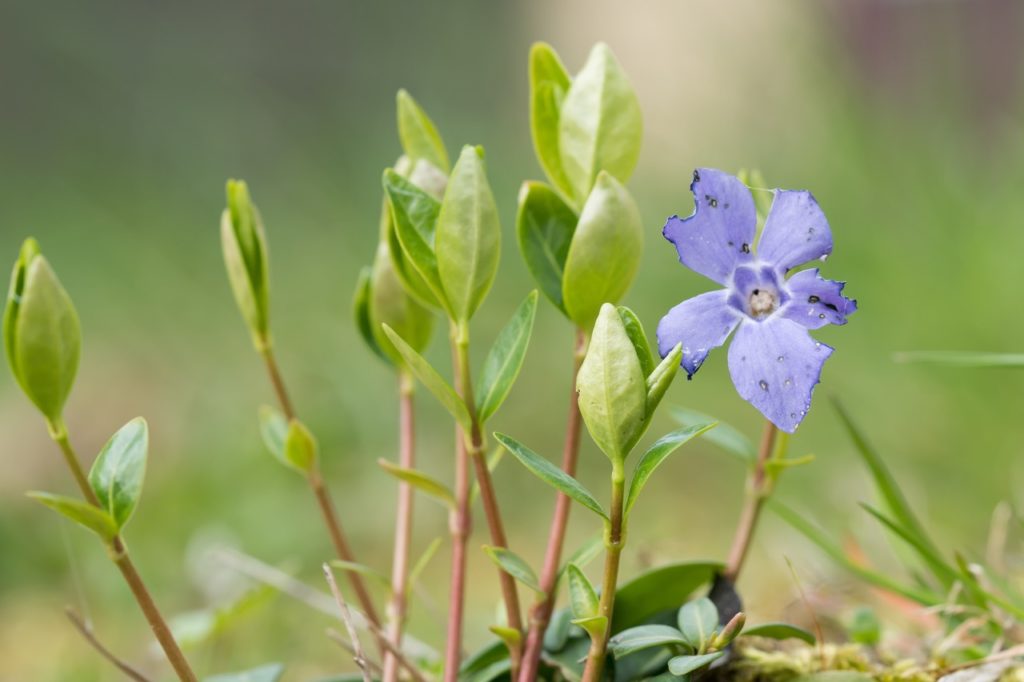
Meanwhile, fungal diseases such as botrytis blight can also be a problem from time to time, with the most notable symptoms including leaf spots, wilting and dieback.
You can avoid this problem from occurring by focusing on the soil rather than the foliage when watering the plants, as well as improving air circulation by thinning out the leaves and leaving enough space between plants.
Companion Planting
Because it’s a drought-resistant plant, V. minor plays well with most others and there are no specific specimens that I’d recommend to accompany it.
However, a favourite planting location for me is underneath a garden tree, since most plants will struggle to thrive in the shade thrown by the canopy.
“I tend to use Vinca minor if the object is purely ground cover to suppress weeds in an area (particularly dry shade),” shares Master Horticulturist Colin Skelly.
“Its tendency to spread inexorably (though not as aggressively as V. major) means that it doesn’t associate well with a mixed perennial planting.”
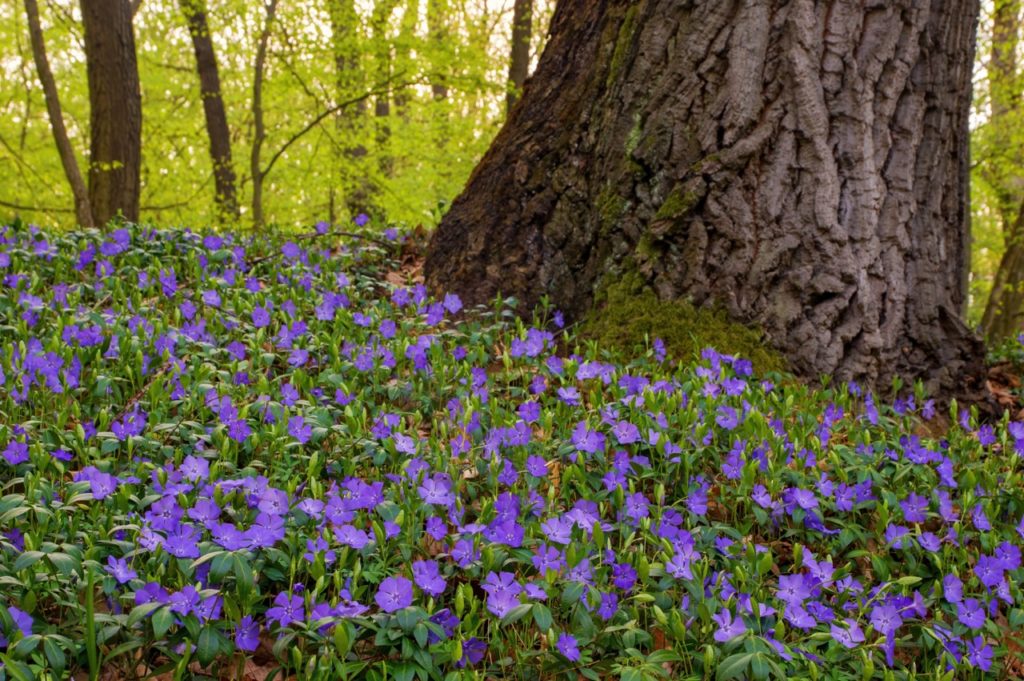
Its ease of cultivation and spreading tendencies also make it ideal for filling out a barren stretch of a rockery or flower bed.
Just be careful that it doesn’t step on the toes of any neighbouring flowers in the vicinity.
It’s also important to ensure that the location is right before planting since it’s difficult to uproot after the fact – but more on that in the next section.
Getting Rid Of Periwinkle
While periwinkle can be tricky to get rid of once it has taken hold, it is possible, especially when dealing with V. minor.
Using a hand trowel, unearth all parts of the plant you wish to remove, including the entirety of the root ball, and then dispose of it in garden waste bags rather than dumping it on the compost heap.
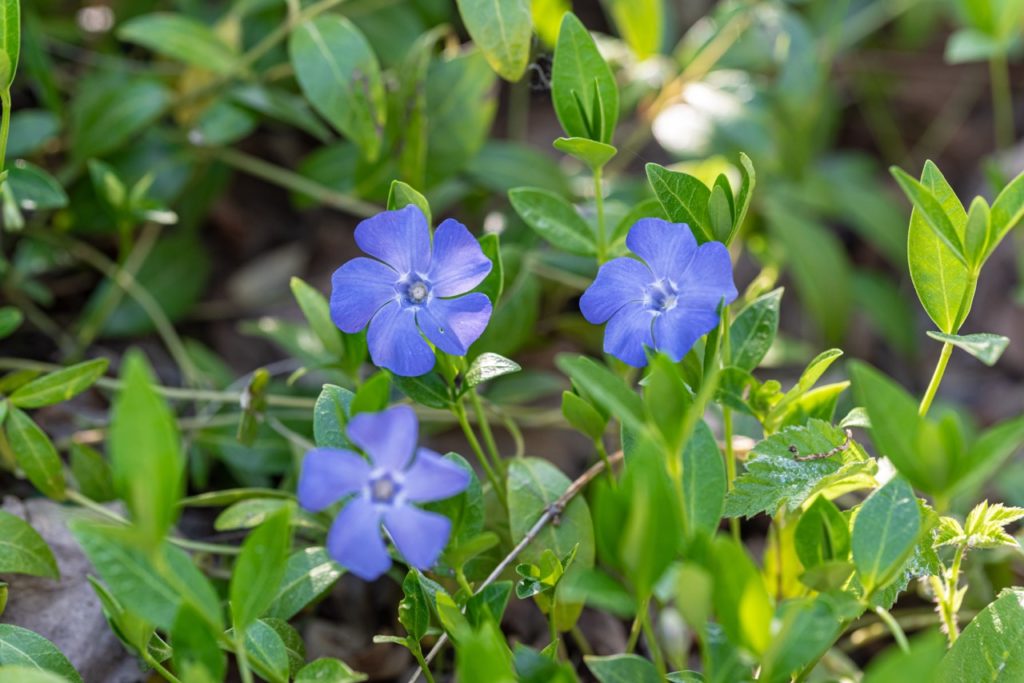
This latter step is especially important if it’s V. major rather than V. minor you’re handling, as the former can send down new roots even when unearthed.
Only use a weedkiller as a very last resort, since contamination of any plants in the vicinity will kill them off, too.
Apply to the leaves and let them suck the poison down into their roots.
How Quickly Does Periwinkle Spread?
Although V. minor is not as rapid as V. major, it will still spread fairly quickly once it is established.
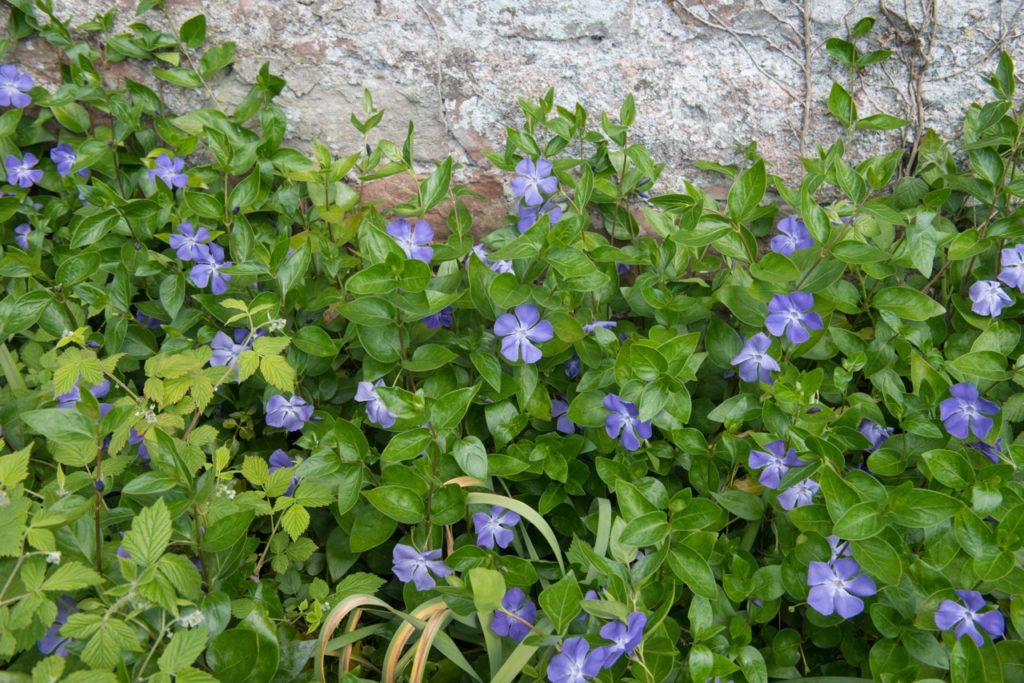
If planting from seed, you should have patience and expect things to progress slowly for the first couple of years.
However, after that, or if propagating via division, the periwinkle will cover an area of up to 1m or more in a single year.
References
- 1Vinca minor. (n.d.). Kew Royal Botanic Gardens. Retrieved March 22, 2023, from https://powo.science.kew.org/taxon/urn:lsid:ipni.org:names:82701-1
- 2Vinca major. (n.d.). Plant Right. Retrieved March 22, 2023, from https://plantright.org/invasive/vinca-major/

